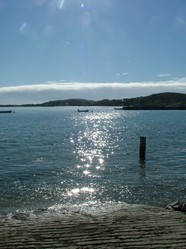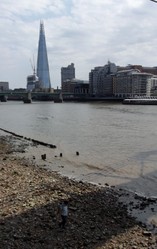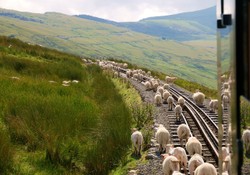Beginning with the Isle of Man, the largest isle in the book and a partly independent country in its own right, he proceeds through the Scottish isles of South Ronaldsey, Barra and Eigg, before turning to the Irish Rathlin. We then read the sad tale of Alderney, the channel island used by the Nazis as a concentration camp, then the smaller St Martins in the Isles of Scilly before returning to the once inhabited Scottish isle of St Kilda and the sad account of its abandonment. The book finishes with Bardsey, the one time sacred isle off North Wales, before finishing with two uninhabited English islands off the south east coast of England.
Each of these ten islands is discussed in full, with its unique history given and its culture sympathetically presented. As a Briton, I realised from reading this book how little I knew of the Isle of Man, an island state only about a hundred miles from my home in North West England, and this book has gone some way to rectifying this deficiency in my knowledge.
The book gives material drawn from history, archaeology, geography, literature, politics science and religion. With my religious interests I was particularly interested in Bardsey, the Isle of Ten Thousand Saints, off the Welsh coast, guarded by fierce tides and currents, but still inhabited by a warden and his family and several hermit nuns. I was curious about the way in which places acquire a spirit, character of presence, which is perhaps the trace of the deeds done there. The book gave me some room for reflection on these matters, though answers are in short supply.
Islander makes us reflect on the negative effect of the dominant urban culture on more traditional local cultures and how the western economic system erases local identities and local cultures. Islander poses a challenge to us all as to how we respond to this erasure.
Reading the book led me to the conclusion that islands are interesting for the human events that happen on them. Even the two uninhabited isles at the end of the book have a human history whose traces linger within their shores. Without this history there would be some flora and fauna to discuss, but as these isles contain no unique species we need not say much. Humans make the world interesting to a great extent.
Islander is a well-written book that will give great pleasure to the thoughtful reader. It was a delightful Christmas presence from my second son. I read it all with delight and commend it to the reader.









 Pilgrimage. A review17 days ago
Pilgrimage. A review17 days ago
 Leo the Fourteenthon 05/09/2025
Leo the Fourteenthon 05/09/2025
 The Melsonby Hoardon 03/25/2025
The Melsonby Hoardon 03/25/2025



Comments
No. The Hebrides, Orkney and Shetland are out of sight of the mainland, as are St Kilda and Fouls.
The fifth paragraph to the first subheading, The theme of the book, describes author Patrick Barkham as "interested in islands, as he is in coastlines."
That last word encourages me to think of insular and mainland coastlines.
Might all eastern-pond islands be within sight of mainland coastlines?
I am surprised that the film was shot with Irish landscapes, as the two lands are dissimilar. But there are great sea cliffs in Ireland. The highest is Croaghaun on Achill Island in Mayo, above where I once camped, then Slieve League [Liag] in Donegal; after this come the Cliffs of Moher in County Clare. Other areas less towering, but where mountains are close to the sea are in County Kerry in the South West. All the four areas that I identify here are in the West of Ireland, but there are smaller cliffs on the north coast near the Giant's Causeway. The Irish rocks most similar to the rocks of Iceland are the basalt landscapes near the Giant's Causeway. Northern Ireland is proving attractive to film makers [Game of Thrones] so I would not be surprised if films were shot near there.
Revisiting your wizzley caused me to ponder what Ireland and United Kingdom islands -- including and beyond the 10 referenced here -- look like.
Ragnar Jónasson is releasing the English version of the second of his stand-alone novels at the end of June. So I looked to Vikings television series to get me thinking along Icelandic geographical lines, only to find that it's filmed in Ireland!
Some of the landed scenes and some of the water views of island coastlines make me think of Iceland, where I've been.
Would Ireland look toweringly mountainous along its coastlines, or, if not, would its islands look that way?
The number that you quote is accurate, but I suggest that whoever was the author of that saying thought that all those buried there were saints. St Elgar, a Saxon who was enslaved in Ireland, but who escaped dwelt there. Monks' graves are all over the island, but monastic graves are unmarked as monks regard the body as dispensable.
When the nuns leave nothing will happen, but when a warden leaves the trust who manage the island will simply appoint another
frankbeswick, Thank you for the backstories and products. Do you know who are the saints buried there and where? (An article, Edge of Wales Walk Umylon Cymru, referenced in the Wikipedia article on Bardsey Island mentions the number as 20,000. Is that an error or is there some disagreement on numbers?) What will happen to Bardsey should the hermit nuns and the warden and his family die, move or retire?
A bailiwick is an ancient term for an area of jurisdiction. Elizabeth exercises jurisdiction in the bailiwicks of Jersey and Guernsey. Why Alderney uses regina I do not know. Sark is a self-governing part of the bailiwick of Guernsey. It is a feudal relic.
I am not quite certain of what the meaning of the word bailiwick, but Elizabeth II is referred to as bailiwick on the Guernsey coinage. Aldemey uses Regina, as do several other places.
Slight counting error. Three isles from the eleven are English, four are Scottish, one is Welsh, one Northern Irish, and there are two others.
Don't confuse the Isles of Scilly,which are part of the English county of Cornwall and in the Western Approaches, with Sicily. The Isles of Scilly have nothing to do with Sicily. All isles mentioned in the article, but two are in the UK, though only the two small ones are English. Others belong to Scotland, Wales and Northern Ireland.
Man and Alderney are not UK. The Isle of Man is a crown dependency, which makes its own internal laws, but is dependent for foreign policy on the UK. The queen is Lord of Man. Alderney is in the Channel Islands, which are three crown dependencies Guernsey, Jersey, Sark. Guernsey includes Alderney. They are the last remnants of the old Duchy of Normandy, and they hail Elizabeth not as their queen, but as their duchess.
There is geological evidence that in Roman times the Scillies were a single isle that the Romans called Insula Scillonia, but sea level rise swept away much land, leaving the fragmentary archipelago that we now know.
By the way, Scillonians don't like their home called the Scilly Isles [because Scilly is pronounced silly!
The word Scilly is related to skelly, and skerry, words meaning a cluster of rocks.